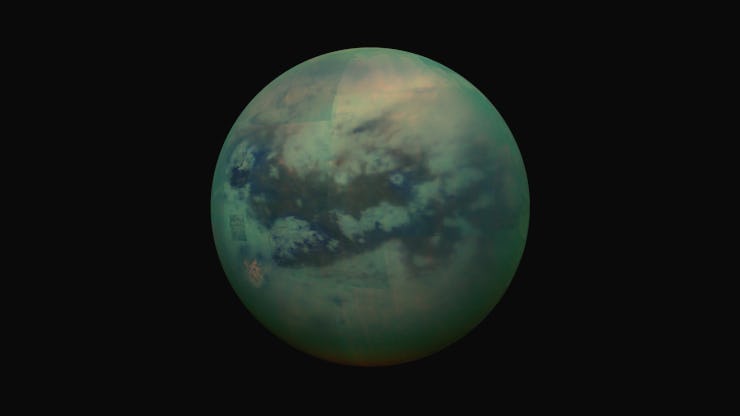We've Just Learned Something Extremely Violent About Titan, Saturn's Unforgiving Moon
Lakes on Titan may have exploded their way into existence.

The lakes that sit on the very cold, rocky surface of Titan, Saturn’s largest moon, aren’t ones that invite you to lay out and relax.
Unlike Earth’s lakes, the ones on Titan are filled with flammable greenhouse gases, and new radar imagery suggests that they may have also been formed by exploding nitrogen bombs.
Until recently, scientists believed that the lakes on Titan (which has average temperatures reaching -290 degrees Fahrenheit) formed when methane melted its bedrock of water ice, creating these gaseous reservoirs, the same way karstic lakes are created on Earth when water dissolves its surrounding limestone.
However, a team of researchers has come up with a new model for what led to the formation of Titan’s lakes, suggesting that nitrogen stored below the surface may have exploded, a result of warming temperatures. The explosions created craters on the moon that later filled up with liquid gas.
This artist's concept of a lake at the north pole of Saturn's moon Titan illustrates raised rims and rampartlike features such as those seen by NASA's Cassini spacecraft around the moon's Winnipeg Lacus. New research using Cassini radar data and modeling proposes that lake basins like these are likely explosion craters, which could have formed when liquid molecular nitrogen deposits within the crust warmed and quickly turned to vapor, blowing holes in the moon's crust. This would have happened during a warming event (or events) that occurred in a colder, nitrogen-dominated period in Titan's past. The new research may provide evidence of these cold periods in Titan's past, followed by a relative warming to conditions like those of today. Although Titan is frigid compared to Earth, methane in the atmosphere provides a greenhouse effect that warms the moon's surface.
Researchers reported their findings Monday in a study, in the journal Nature Geoscience. Their analysis was based on radar data gathered by Cassini — the orbiter sent to Saturn in 1997 — as it flew by Titan two years ago, just before diving into Saturn’s atmosphere to dramatically end its 20 years in space.
The radar imagery from Cassini showed steep rims, rather than sharp boundaries, surrounding a number of the smaller lakes near Titan’s north pole, which could not be explained by the original model.
“The rim goes up, and the karst process works in the opposite way,” Giuseppe Mitri, senior scientist at G. d’Annunzio University in Italy and lead author of the study, said in a statement.
Titan is believed to have gone through periods of cooling and warming, with methane levels in its atmosphere increasing and decreasing over time. Nitrogen was once abundant in Titan’s atmosphere when the moon was even colder than it is today, raining down and forming pools
“These lakes with steep edges, ramparts and raised rims would be a signpost of periods in Titan’s history when there was liquid nitrogen on the surface and in the crust,” Jonathan Lunine, planetary scientist at Cornell University in Ithaca, New York and co-author of the study, said in the statement.
However, as the temperatures on Titan started to increase, it caused the nitrogen liquid to evaporate, expand and essentially turn into an explosive bomb.
Scientists first discovered evidence for lakes on Titan’s surface back in 2007 through the Cassini mission, revealing a planetary body that holds some similarities to Earth but also has some very alien characteristics.
Data collected from Cassini will continue to feed astronomers’ knowledge of Saturn and its accompanying moon.
Abstract
The Cassini mission discovered lakes and seas comprising mostly methane in the polar regions of Titan. Lakes of liquid nitrogen may have existed during the epochs of Titan’s past in which methane was photochemically depleted, leaving a nearly pure molecular nitrogen atmosphere and, thus, far colder temperatures. The modern-day small lake basins with sharp edges have been suggested to originate from dissolution processes, due to their morphological similarity to terrestrial karstic lakes. Here we analyse the morphology of the small lake basins that feature raised rims to elucidate their origin, using delay-Doppler processed altimetric and bathymetric data acquired during the last close flyby of Titan by the Cassini spacecraft. We find that the morphology of the raised-rim basins is analogous to that of explosion craters from magma–water interaction on Earth and therefore propose that these basins are from near-surface vapour explosions, rather than karstic. We calculate that the phase transition of liquid nitrogen in the near subsurface during a warming event can generate explosions sufficient to form the basins. Hence, we suggest that raised-rim basins are evidence for one or more warming events terminating a nitrogen-dominated cold episode on Titan.